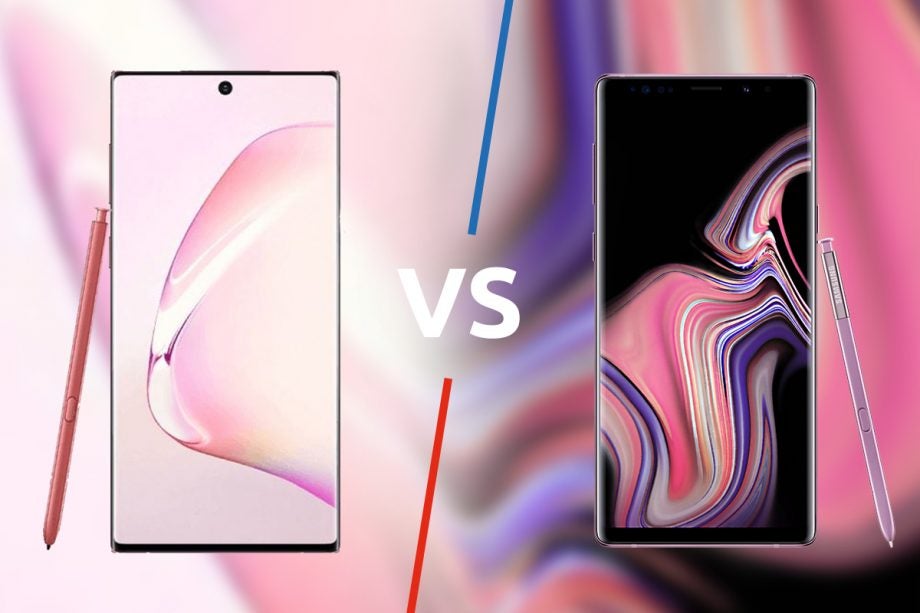Samsung Galaxy Note 10 vs Galaxy Note 9: It’s a closer race than you’d think

The Samsung Galaxy Note 10 and Samsung Galaxy Note 10 Plus are finally here. After months of spurious leaks, the two phones have been officially unveiled, and from what we’ve seen they have the chops to crown Samsung as the king of the phablets for yet another year.
This year everything from the design down to the Galaxy Note 10 phones’ internal hardware have been given a refresh. While this is on the one hand awesome, it also means you may be struggling to figure out what the coolest new features are, and more importantly, how the Note 10 line compares to Samsung’s previous flagship phablet: the Samsung Galaxy Note 9.
Here to help, we’ve created a definitive guide detailing the core differences between Samsung’s old and new flagship phablets.
Samsung Galaxy Note 10 vs Galaxy Note 9: Price
The Galaxy Note 10 and Note 10 Plus aren’t cheap. The basic Note 10 will retail SIM-free for £869. The Plus will set you back an even heftier £999. If you want to go 5G you’re talking about parting with £1099.
This puts the basic Note 10’s price in line with the Galaxy Note 9, which retailed for £899 when it first came out. But, before you go reaching for your wallet, remember the Note 9 has since been treated to a lot of significant discounts. You can pick it up at certain retailers for as little as £500 right now.
Samsung Galaxy Note 10 vs Galaxy Note 9: Specs
A year old phone is never going to match the specs of a brand new, just released, flagship and this remains true when comparing the Note 10 to the Note 9. But if you take a closer look you’ll find the Note 9 is still a compelling bit of hardware, especially at its current price.
You can see a full breakdown of all three phones’ specs in the table below:
Related: Best smartphone
| Galaxy Note 10 Plus | Galaxy Note 10 | Galaxy Note 9 | |
| Screen | 6.8-inch Dynamic AMOLED Infinity-O, 3040 x 1440, 498PPI, HDR10+ | 6.3-inch Dynamic AMOLED Infinity-O, 2280 x 1080, 401PPI, HDR10+ | 6.4-inch, 2960×1440
516 ppi |
| Display Hz | 60Hz | 60Hz | 60Hz |
| Chipset | Unconfirmed Qualcomm/7nm Exynos 9825 | Unconfirmed Qualcomm/7nm Exynos 9825 | Snapdragon 845/Exynos 9810 |
| RAM | 12GB | 8GB | 6/8GB |
| Storage | 256/512GB | 256GB, no microSD | 128/512GB, microSD |
| Camera (main) | 16-megapixel (f/2.2, 123-degrees) | 16-megapixel (f/2.2, 123-degrees) | 12-megapixel variable aperture main camera, |
| Camera (Secondary) | 12-megapixel (f/1.5 – f/2.4, OIS) Ultrawide | 12-megapixel (f/1.5 – f/2.4, OIS) Ultrawide | 12-megapixel secondary 2x zoom camera |
| Camera (tertiary) | 12-megapixel (f/2.1, OIS) Telephoto | 12-megapixel (f/2.1, OIS) Telephoto | None |
| Camera (fourth) | DepthVision camera VGA f/1.4 | None | None |
| Camera (front) | 10-megapixel, f/2.2 | 10-megapixel, f/2.2 | 8-megapixel |
| Battery | 4300mAh | 3500mAh | 4000mAh |
| Charging type | 45w capable, 25w in box | 45w capable, 25w in box | Fast Charging compatible on wired and wireless |
| Fingerprint | In display | In display | Physical rear |
Samsung Galaxy Note 10 vs Galaxy Note 9: What’s new?
The Note 10 and Note 10 Plus borrow heavily from Samsung’s regular Galaxy S10, which makes them very different to the Note 9 both on the inside and out.
Starting with the basics, the Galaxy Note 10 and 10 Plus both use Samsung’s newer 7nm Exynos 9825 CPU and have radically upgraded triple-sensor rear cameras. The new CPU’s smaller manufacturing process means it should be noticeably more power efficient than the older chip seen in the Note 9. We’ll be interested to see if this will let the Note 10, which only features a 3500mAh battery, match the Note 9’s stamina. The Note 9 features a larger 4000mAh cell.
The Note 10 and Note 10 Plus feature a close to identical triple camera setup to the Galaxy S10. This means they should be significantly better at taking photos than the Note 9, which has a dual camera setup. The difference should be particularly noticeable on the Note 10 Plus, which also has a fourth ToF (time of flight) sensor on its back. This will reportedly let it capture space better, letting you take more natural looking portrait/bokeh shots.
Both the new Notes also feature Samsung’s ‘Infinity O’ style front cameras. This means the 10-megapixel front camera is directly embedded into the middle of both phone screens’. We’re not huge fans of the design but it’s still a step up on the notch housing seen on the Note 9.
Related: Best phablet
The hole-punch camera isn’t the only new design feature. Samsung’s also cut the headphone jack and microSD card slot from both versions of the Note 10 – two moves we are Trusted Reviews aren’t exactly thrilled by.
Both the new Notes also feature reworked chassis and support for 45W fast charging. The Note 9 caps out at 15W by comparison. The only downside is that you’ll have to pay extra to take advantage of the new Notes’ improved charge speeds, as both come with 25W chargers in of the box.
The final differences relate to the Galaxy Note 10 and Note 10 Plus’ software and S Pen. The Galaxy Note 10 and Galaxy Note 10 Plus both feature Samsung’s OneUI software, which aims to reduce the amount of bloatware and needless UI changes made to the phones’ core Android OS. The Note 10 also features custom gaming modes. These will let you do things like connect the Note 10 to a PC and use it as a controller when streaming games via the new PlayGalaxy app.
Air Gestures are the only notable addition to the new S Pen. These let you enact certain commands, like zooming in on photos and raising the phones volume, and using gesture shortcuts while floating the S Pen over the screen.
Related: Best Samsung phone
Samsung Galaxy Note 10 vs Galaxy Note 9: Early verdict
The Galaxy Note 10 and Galaxy Note 10 Plus offer a number of technical improvements on the Note 9. Highlights include upgraded triple-sensor rear cameras, a completely rethought design and the use of a more efficient 7nm CPU.
If you want a top end phablet the Note 10 is the way to go. But if you’re on a budget and don’t fancy paying £1000 for a phone, the Note 9 still offers fairly impressive hardware and a feature set that matches, if not beats, most phones in its new £500 price bracket.


